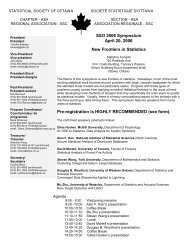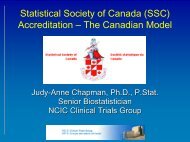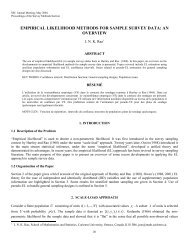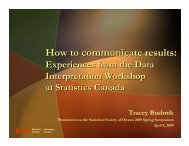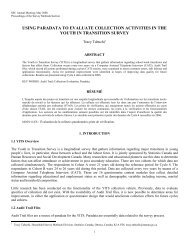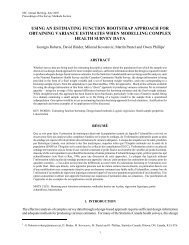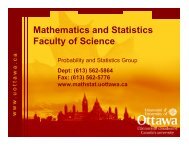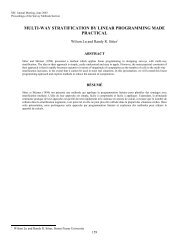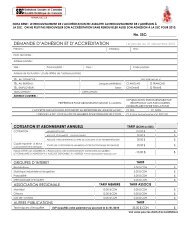Programme et résumés (pdf) - Société statistique du Canada
Programme et résumés (pdf) - Société statistique du Canada
Programme et résumés (pdf) - Société statistique du Canada
You also want an ePaper? Increase the reach of your titles
YUMPU automatically turns print PDFs into web optimized ePapers that Google loves.
Mardi 30 mai • Tuesday, May 30, 13:15–14:45 117l’analyse doivent souvent incorporer la des modèles de po-pulation ou d’écosystème régis par des équations différentiellesnon linéaires. Dans c<strong>et</strong>te présentation, je discuterai del’estimation dépendante <strong>du</strong> temps de l’état <strong>et</strong> des paramètrespour de tels systèmes dynamiques stochastiques. Le modèlenon linéaire <strong>et</strong> non gaussien général de l’espace d’état four-nit le cadre, avec des méthodes Monte-Carlo séquentiellesrapportant des solutions basées sur l’échantillonnage. Desproblèmes dans la prévision écologique marine sont discutés.ten must incorporate population or ecosystem modelsgoverned by nonlinear differential equations.In this presentation, I will discuss time dependentestimation of the state and param<strong>et</strong>ers for suchstochastic dynamic systems. The general nonlinearand non-Gaussian state space model providesthe framework, with sequential Monte Carlo m<strong>et</strong>hodsyielding sampling based solutions. Problemsin marine ecological prediction are discussed.[MS-116]Using Robust Hierarchical State Space Switching Models to Elucidate the Behaviour of Seals and Turtles atSeaUtilisation des modèles à changements de régime hiérarchiques d’espace d’état robustes pour élucider lecomportement des phoques <strong>et</strong> des tortues marinesRansom MYERS, Ian JONSEN, Greg BREED, Mike JAMES & Joanna FLEMMING, Dalhousie UniversityMême l’observateur le plus occasionnel des animaux noteraqu’ils ont des modes de comportement distincts, c.-à-d. ilsvont paître, ils cherchent de la nourriture, ils se reposent, <strong>et</strong>ils émigrent. Ces modes de comportements changent avecle temps en réponse à des variations dans l’environnement.Le but de c<strong>et</strong>te présentation est de fournir un cadre analy-tique à l’aide de modèles afin d’analyser ces comportements.Spécifiquement, nous modélisons des données obtenues parsatellite qui perm<strong>et</strong>tent d’identifier le passage des animaux.Nous utilisons un cadre d’espace d’état hiérarchique robustepour m<strong>et</strong>tre en application des modèles de commutation.Avec l’arrivée récente de procédés de poursuites sophisti-qués, les grandes quantités de données qui décrivent claire-ment un tel comportement dans le temps <strong>et</strong> dans l’espacedeviennent disponibles. Nous montrons comment les mo-dèles de commutation espace-état peuvent être utilisés pouridentifier les comportements des phoques <strong>et</strong> des tortues ma-rines par des repères liés au satellite, ce qui est crucial pourla conservation de ces espèces. C<strong>et</strong>te approche perm<strong>et</strong> auxécologistes d’étudier certaines questions qui pouvaient difficilementl’être avec les approches conventionnelles.Even the most casual observer of animals will notic<strong>et</strong>hat they have distinct behavioural modes, i.e.,they forage, they search for food, they rest, they migrate.These behavioural modes change over timein response to environmental variation. The purposeof this talk is to provide a modeling frameworkto analyze such behaviour. Specifically, wemodel data from satellite tracks using a robusthierarchical state space framework to implementswitching models. With the recent advent of sophisticatedtacking m<strong>et</strong>hods large amounts of datathat clearly describe such behaviour in time andspace are becoming available. We show how statespaceswitching models can be used to identify behavioursof seals and marine turtles from satellitelinked tags that is crucial for the conservation ofthe species. This approach allows questions to beaddressed that were previously difficult for ecologistto formulate using conventional approacheswith such data.SH = Somerville House SSC = Social Science Centre UC = University College



